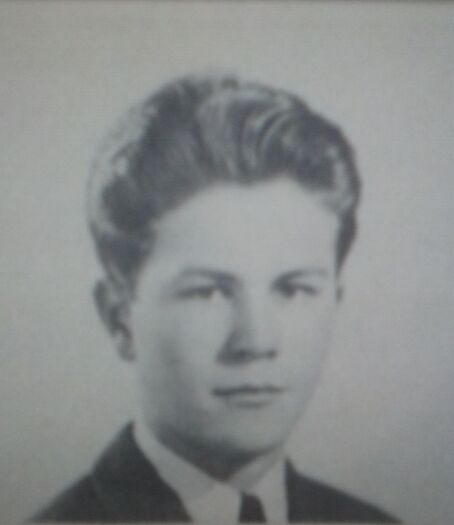LOUIS P. HAGAN, ENS, USNR
Louis Hagan '45
Louis Patrick Hagan was admitted to the Naval Academy from Kentucky on July 5, 1941 at age 19 years 6 months. He resigned on January 29, 1942 with the note "Resignation accepted. Deficient in studies."
Lucky Bag
"Lewis" — spelled incorrectly in the Lucky Bag — Patrick Hagan is listed among those classmates who did not graduate in June 1944 with the Class of 1945.
Loss
Louis was killed in action during the landing at Iwo Jima on February 17, 1945. He was one of five officers in a typical compliment of USS LCI(G) 471. (LCI = Landing Craft, Infantry; the "G" indicated that the ship didn't actually land ground forces but instead provided fire support with rockets and 40mm and 20mm guns.)
From an account on the action of an LCI(G) Group at Iwo Jima:
11:32 - Having received two additional hits which killed nine men, wounded six, disabled the bow 40mm gun and started another fire, LCI (G) 471 was ordered to retire.
Other Information
He was from Elizabethtown, Kentucky. In the 1940 census he lived with his mother, Alta Rose; sister Rose Minnie (25); and brother Kenneth (22). His grandfather Lee Hagan and grandmother Lizzie lived nearby.
The Story of LCI(G) 471
From “USS LCI - Landing Craft Infantry":
By Ensign LM. Hermes, Jr.
The LCI(G) 471 started as steel plate in Barber, NJ where it was built and ended as scrap steel near Vallejo, California, where it was towed after decommissioning at Treasure Island. Although its beginning and end were rather ordinary events, the intervening interval of time saw this ship as an actual entity whose life was marked with extraordinary events. This story of the LCG) 471 is a brief record of the more salient events of its life.
The 471 was built as an LCL in Barber, NJ and picked up its first crew at Pier 42 in the Hudson River in New York. The commanding officer was Lt. George Waidner. After training exercises in the Solomon Islands, MD area the 471 proceeded through the Panama Canal to San Diego where it was converted to a gunboat and became LCI(G) 471 in early 1944. The ramps on both sides of the ship were removed and replaced with rocket launchers capable of firing over five hundred 4.5 inch rockets in one minute. Gunnery on the gunboat consisted of three 40 mm guns (one on the bow and two just forward of the conning tower) and four 20 mm guns (two each on the bow and two aft of the conning tower).
After conversion to a gunboat the 471 went to the Ellice Islands and later to Guadalcanal. Here more training exercises were done preparatory to the invasion of the Mariana Islands. The LCG) 471 underwent its first test of battle in the invasion of Saipan, followed shortly thereafter by the invasions of Tinian and Guam. It worked closely with the underwater demolition teams prior to D-Day landings, giving them close-in fire support protection, and on D-Day bombarded the beaches with rockets and gunfire immediately prior to the landing of troops. The LCI(G) 471 not only came through the Marianas operation unscathed but shot down two Japanese bombers and came to the rescue of the LCI(G) 468 whose bow was blown away by a torpedo launched from a Japanese plane. Other interesting activities of the ship included patrolling near the shore of Guam with a Japanese prisoner who urged (over a loud speaker) his fellow Japanese to come to the beach and surrender. The 471 picked up several dozen prisoners in this manner, but failed to pick up others on a later patrol when they came to the beach and fled to the jungle when they saw Marines.
After Guam was secured, the 471 stayed in the area until January, 1945. Time was about equally divided between being anchored in Apra Harbor and tied up to the hull of the old battleship Oregon at Merizo. The Oregon was loaded with dynamite for the Seabees’ use in construction. The 471 guarded the dynamite and provided work crews for its unloading. In October, 1944 Robert S Hudgins became commanding officer: executive officer was Kingdon Balzer and the engineering officer was Charles Crandall. Three new ensigns. L.M. Hermes, Jr., Louis P. Hagan and David H. Hardy were assigned to the LCI(G) 471 at this time.
In January, 1945 the big secret on the ship was its future role in the invasion of Iwo Jima, an island hardly known to most on board. In late January the LCI(G) 471 and other ships of Group eight (LCI(G)s 346, 348, 438, 441, 449, 450, 457, 466, 469, 471, 473 and 474) assembled in Ulithi atoll, the anchorage area for much of the Pacific fleet, Here the various commanding officers met to make final plans for the invasion of Iwo Jima. Maneuvers, including a rocket bombardment of a small uninhabited island, were carried out. Finally, in early February, the LCI(G) 471 and sister ships in Group Eight left Ulithi for Iwo Jima with a short stop in Saipan for fueling, water and supplies.
February 17, 1945 was a fateful date for the LCI(G) 471 and Group Eight. It was D-Day minus 2 and the larger warships were already gathered in the waters near Iwo Jima when the LCI(G)s arrived early in the morning. The island of Iwo Jima was smoking from aerial and naval bombardments and seemed like the head of some giant serpent or dragon peeping out of the water. It looked ugly and lethal then and lived up to its appearance in the days and weeks to come. Around 11 a.m. the underwater demolition teams departed to inspect the beaches and beach water conditions of the eastern shores of Iwo Jima. The LCI(G)s moved with the demolition teams to provide close in fire support with rockets, 40 mm and 20 mm guns. Two or three of the LCI(G)s, including the 471, were held back in reserve, but were soon called in to replace the stricken gunboats, All of the LCI(G)s received hits from shore batteries and mortars and suffered heavy casualties. As the 471 entered the beach area it passed the 449 to the starboard. It was badly damaged and smoking — only one person was topside and he was staggering towards the fantail. I have later wondered if this was Lt. Herring who won the Medal of Honor for saving his LCI(G) by using the emergency steering at the fantail. On our port side the LCI(G) 474 was lying on its side awaiting a watery grave. The 471 began firing its 40 and 20 mm guns as it moved in closer to the beach to fire rockets. The water around us was full of small geysers made by mortar fire.
The 471 received its first hit from a shore battery that was probably in Mt. Suribachi. The shell hit the portside of the ship near the well deck and exploded in the crew's quarters and started a fire which was soon extinguished. The shell knocked out the electrical system that fired the rockets and disrupted telephone communication from the bridge to the gun crews. A few minutes later a mortar hit the well deck about 5 feet from the rockets in the launchers on the portside. No damage was done other than making a hole in the deck. The guns of the 471 were constantly firing when the ship was hit a third time by a large shell (5 to 7 inch equivalent). The shell entered the gun tub on the starboard side of the bow and exploded itself and all the ammunition piled there. A fire started in the winch room below but it was put out quickly. The carnage was a sight never to be forgotten with the dead, dying and wounded all over the bow and down to the well deck. The 471 went to the Battleship Tennessee to transfer the wounded for medical attention. After this was done the gruesome tasks of cleaning up the carnage and preparing the dead for burial at sea began. In the middle of the afternoon about five miles east of Iwo Jima, I conducted burial services for nine of the eleven people killed. (The other two died on the Tennessee and were buried from that ship). Casualties in addition to the dead included four wounded. The dead of the LCI(G) 471 from the Iwo Jima engagement are Louis P. Hagan, Ens.: R.W. Pond, S 1/c: Richard Cano, S 1/c: J.W. White, F 1/c; Jerry Terraciano SC 2c; Tom Morehouse, S 1/c; B.J. Harris, GM 3/c; J.L. Adamson, S 2/c: Donald Nygard, Cox: Jim Bernethy, SC 3/c and William P. Morrisey, GM 1/c.
Because of the extensive damage and casualties suffered by LCI(G) Group Eight, none of the ships participated directly in the D-Day landings on February 19, 1945. The 471 was two to three miles north of Iwo at this time. One night there was an air raid and bombs were dropped on both sides of the 471 and gave everyone a big scare. The biggest challenge was being underway at night with no light and dodging other ships the entire night, we had some near misses but no collisions. A most memorable event took place on February 23, 1945 in mid morning when some of us saw the flag right after it was raised on Mount Suribachi. Little did we realize one of the most famous photographs of war had just been taken!
All of the gunboats in LCI(G) Group Eight were awarded the highest honor that can be bestowed upon a Navy unit — the Presidential Unit Citation. Numerous medals for performance in battle were awarded to various members of LCI(G) 471, the highest being the Navy Cross to Lt. (jg.) Hudgins, the commanding officer.

The "category" links below lead to lists of related Honorees; use them to explore further the service and sacrifice of alumni in Memorial Hall.
